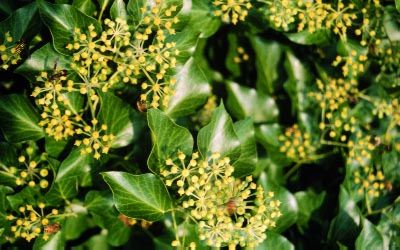Genus: Hedera
Nomenclature
Hedera L., Sp. Pl. 202. 1753. Gen. Pl., ed. 5, 94. 1754. LECTOTYPE: Hedera helix L., designated by Lamarck (1791) by his removing the other species of the genus.Key to the species of Hedera
1. Leaflets pubescent beneath, veins run to the ends of serrations...Aralia elata1. Leaflets nearly glabrous beneath, veins anastomose...Aralia spinosa
List of Hedera Species
References to Hedera
- Ackerfield, J. 2001. Trichome morphology in Hedera (Araliaceae). Edinburgh J. Bot. 58: 259-267.
- Ackerfield, J.; Wen, J. 2003. Evolution of Hedera helix (the ivy genus, Araliaceae): insights from chloroplast DNA data. Int. J. Plant Sci. 164: 593-602.
- Biggerstaff, M. S.; Beck, C. W. 2007. Effects of English ivy (Hedera helix) on seed bank formation and germination. Amer. Midl. Naturalist 157: 250-257.
- Biggerstaff, M. S.; Beck, C. W. 2007. Effects of method of English ivy removal and seed addition on regeneration of vegetation in a southeastern piedmont forest. Amer. Midl. Naturalist 158: 206-220.
- Carter, G. A.; Teramura, A. H. 1988. Vine photosynthesis and relationships to climbing mechanics in a forest understory. Amer. J. Bot. 75: 1011-8.
- Erbar, C.; Leins, P. 1988. Flower development studies in Aralia and Hedera (Araliaceae). Flora 180(5-6): 391-406. (In German; English summary)
- Green, A. F. et.al. 2011. Phylogeny and biogeography of ivies (Hedera spp., Araliaceae), a polyploid complex of woody vines. Syst. Bot. 36: 1114-1127.
- Jacobsen, P. 1954. Chromosome numbers in the genus Hedera L. (Abstr.). Hereditas 40: 252-4.
- Lum, C.; Maze, J. 1989. A multivariate analysis of the trichomes of Hedera. Watsonia 17: 409-18.
- Meehan, T. 1871. On the flowers of Aralia spinosa L. and Hedera helix L. Ann. Mag. Nat. Hist. 7: 315-6.
- Parker, J. 1962. Relationship among cold hardiness, water-soluble protein, anthocyanins and free sugars in Hedera helix L. Pl. Physiol. (Lancaster) 37: 809-13.
- Robbins, W. J. 1960. Further observations on juvenile and adult Hedera. Amer. J. Bot. 47: 485-91.
- Russell, A. B. 1997. Poisonous plants of North Carolina.
- Sheriff, D. W.; Meidner, H. 1974. Water pathways in leaves of Hedera helix L. and Tradescantia virginiana L. J. Exp. Bot. 25: 1147-56.
- Stein, O. L.; Fosket, E. B. 1969. Comparative developmental anatomy of shoots of juvenile and adult Hedera helix. Amer. J. Bot. 56: 546-51.
- Steponkus, P. L. 1971. Cold acclimation of Hedera helix: evidence for a two phase process. Pl. Physiol. (Lancaster) 47: 175-80.
- Steponkus, P. L. 1968. Factors affecting cold acclimation of Hedera helix. Morris Arbor. Bull. 19(3): 41-6.
- Steponkus, P. L.; Lanphear, F. O. 1968. The role of light in cold acclimation of Hedera helix L. var. Thorndale. Pl. Physiol. (Lancaster) 43: 151-6.
- Stout, D. G. 1976. A study of plant cell water permeability and of the cold acclimation process in ivy bark. Ph.D. Dissertation Cornell Univ., Ithaca, NY,
- Stout, D. G.; Steponkus, P. L.; Cotts, R. M. 1978. Plasmalemma alteration during cold acclimation of Hedera helix bark. Canad. J. Bot. 56(2): 196-205.
- Thomas, L. K. 1998. Topographic alterations, forest structure, and invasion by English ivy (Hedera helix L.) in the Rock Creek floodplain, Washington, D.C.. Natural Areas Journal 18: 164-168.
- Vezza, M. et.al. 2006. Ivy (Hedera helix L.) flower nectar and nectary ecophysiology. Int. J. Plant Sci. 167: 519-527.
- Yi, T. et.al. 2004. Chromosomal evolution in Araliaceae and close relatives. Taxon 53: 987-1005.
